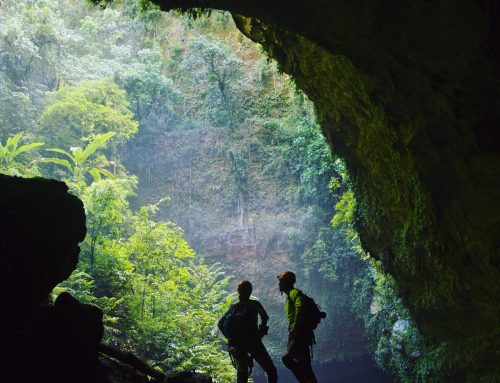Dressed in a skin-tight wet suit, a blue helmet and a bright red life jacket, I clumsily paddled my way into the pursed mouth of a narrow limestone cave. Snarls of foamy saliva-like waves lapped up against the rock’s jagged jaws, and – as a tidal surge swept over my sit-on-top kayak shoving me towards a serrated stucco cave wall – there was nothing left to do but duck limbo-style and hope for the best.
Typically, sea cave kayaking in this part of California’s Channel Islands involves wide open, well-lit, bat-free rock openings, but this particular cave one was more of a challenge. With a little paddling prowess and a strong partner, I narrowly avoided being smashed, face-first against a roof of barnacles. Luckily, rhinoplasty by crustacean was not on today’s itinerary but excitement sure was….
This thrill of adventure was what brought me here in the first place. Scorpion Anchorage Santa Cruz Island is the largest of the Channel Islands and is located some 20 miles from the mainland of Ventura Harbor. Home to some 2,000 species of plants and animals, of which 145 are found nowhere else in the world, the Channel Islands are said to be like the Galapagos Islands, where isolation has allowed evolution to take its course. The result is a diverse endemic wildlife unlike any other, including the island fox, the munchkin dudleya, and the bright blue Island Jay. Depending on the season and migration patterns you can also spot dolphins, sea lions, seals and grey whales swimming off shore.
Santa Barbara Adventure Company (http://www.sbadventureco.com/) offers many outdoor adventure activities within the region, from paragliding, to rock climbing, surf lessons to this – a guided one-day sea kayaking trip through Channel Island’s caves.
Our day began when Kenji Webb, our knowledgeable tour leader and field guide, distributed our kayaking gear, gave us a safety debrief and walked us through the basics of the perfect paddle. After scribbling our names on liability waivers, four couples in banana-bright kayaks set out single file, paddling through the cold choppy waters of the Pacific Ocean.
Scaling the shoreline, we were introduced to the geographical formations of the island: coastal bluffs, sharp spiny fault lines and stone versions of Rorschach inkblots that resemble white elephants. We learned that the Channel Islands were home to pygmy mammoths, a variation of the Columbian mammoth species that swam ashore from the mainland some 20,000-40,000 years ago. At four to six feet tall, these mini mammoths freely roamed the island. Today, while these prehistoric creatures are now extinct, their fossils and their legend remain.
Paddling the kayak head-on through unforgiving swells, past dense kelp forests and the occasional curious sea lion poking his head out from beneath the ocean surface, our group followed Kenji into a protected area sheltered from the wind. He took the time to explain a bit about the region’s flora and fauna, before plucking a saffron coloured sea star (a.k.a starfish) from a lava-pocked rock and passed it around. Handling the prickly invertebrate, I paid close attention to its tiny, suction-cupped tube feet used to cling to rocks and trap prey. Sea stars are fascinating little creatures. Not only are they carnivorous, bloodless and eat with their stomachs inside out, but sea stars can regenerate lost limbs like Marvel superheros.
A visit to the Channel Islands goes beyond just a kayaking excursion. It’s a look at some unique coastal wildlife and enjoy the remote wilderness just outside the city.
What You Need to Know Before You Go:
-If you’re flying to California or planning a rental car road trip to Ventura, use your rewards Card to offset the cost. I use the American Express Gold Rewards Card which offers double points on eligible gas, grocery, drugstore and travel spending. The points add up quickly so you can use them towards future travel, hotel or vacation packages without the pain of blackout dates or other restrictions.
-As with any adventure, there can be some risks associated with sea cave kayaking. It’s best to listen to the guide’s instructions, come equipped with the proper gear and always have insurance. Some Credit Cards, like the American Express Gold Rewards Card, offer travel related insurances to Cardmembers. Before heading out on your trip check to see what’s covered by your Card- if you run your kayak into an agitated sea lion, you could be covered for emergency medical expenses.
-The journey begins at Island Packers Dock in Ventura Harbor (about 30 miles south of Santa Barbara) with an hour boat ride from the California mainland to Scorpion Anchorage on Santa Cruz Island. Bring something warm to wear because the boat can be quite chilly.
-Since there are no services on the island, don’t forget to pack everything you need for the day: water, lunch, snacks, sunscreen, hat, sturdy shoes, and a warm change of clothes. Dress in layers and leave the cotton at home. You can leave your valuables (or anything you don’t want to get wet) in a storage box on the island while you kayak. Santa Barbara Adventure Company provides wetsuits, life jackets and paddle jackets specific for kayaking.
-Expect to kayak about three hours, approximately 2.5 miles depending on weather conditions, plus there is time afterwards to explore Santa Cruz Island and hike around.
-To book a sea kayaking tour, visit Santa Barbara Adventure Company http://www.sbadventureco.com/adventures/channel-islands/#sea-cave-kayaking
Happy kayaking!











